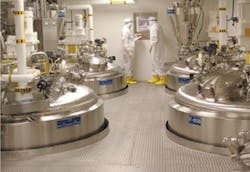Few industries, that is, the ones that actually make something, seem to have attained the luster and momentum than Biopharma has over the last decade or so. The category has really gone upscale since the days when vaccine manufacture had more of an agricultural feel to it rather than the high-science, high-tech aura that makes it shine today, a luster attracting billions in recent capital investment, while producing dramatic gains in successful therapeutic care and patient outcomes across several important categories.
Pharmaceutical enterprises associated with biotechnologies are widely acknowledged to be engines of economic prosperity and a driver of high-paying jobs. The number of states fielding biotechnology-based economic development bureaus, agencies and initiatives is growing as well, with folks working ever harder to bring the industry to their communities.
[sidebar id =1]According to Biotechnology Industry Organization (BIO), the bioscience industry is one of the most innovative and important economic drivers in the United States, accounting for more than 1.6 million jobs and an additional 5 million due to the economic multiplier effect. A significant number of those “biotechnology” jobs are associated with pharmaceutical development. The U.S. Chamber of Commerce also notes that more than 810,000 people work in the biopharmaceutical industry and that the industry supports another 3.4 million jobs across the U.S. economy.
Each year Bioplan Associates Inc. publishes the comprehensive font of biopharmaceutical market intelligence. In its 11th annual “Report and Survey of Biopharmaceutical Manufacturing Capacity and Production,” author Eric S. Langer frames the value and scope of the market, which Bioplan Associates pegs at about $190 billion. “This includes all biopharmaceuticals, i.e., biotechnology-derived pharmaceuticals, including classic biologics, such as vaccines and blood/plasma products,” says Langer.
Not surprisingly, recombinant proteins/antibodies have passed a milestone, “now constituting >50% of biopharmaceutical revenue/sales and with sales now crossing the =$100 billion/year threshold,” notes Langer. Among these products, says the report, monoclonal antibodies (mAbs) account for the largest portion, or about $50 billion in sales. “The biopharmaceutical market now constitutes =15%, approaching 20%, of the world’s total pharmaceutical market, which is now essentially at $1 trillion/year,” explains Langer, with growth projected overall to be “approximately twice that experienced by non-biopharmaceutical products, e.g., small molecule-based drugs.”
Bioplan Associates’ research says we can assume that future growth in biopharma sales will likely continue at an approximate 15 percent rate.
The advent of biosimilars will certainly have an accumulating impact on the market as well, once regulators settle on policies that they feel will address consumer safety concerns. Langer covers this important topic more thoroughly in “Risks and Rewards in the U.S. Biosimilars Pipeline,” on page 17. But to summarize, Langer notes in the study that contractions due to biosimilars and cost controls in the U.S. and other major markets will be more than compensated for by organic growth in the market.
In its March 2014 Securities and Exchange Commission filing, Quintiles, self-described and widely acknowledged as the world’s largest provider of biopharmaceutical development services and commercial outsourcing services, estimates total biopharmaceutical spending on drug development was approximately $93 billion in 2013, noting that it expects its Product Development services group will see a CAGR of 6-8 percent through 2016 “as a result of increased research and development, or R&D, spending by biopharmaceutical companies and the increased outsourcing of this spending as compared to 2012.”
BIG SPENDERS
Quintiles estimated that R&D spending was approximately $137 billion in 2013 and is likely to grow to ~ $145 billion by 2016, “with development accounting for approximately 68% of total expenditures. R&D spending trends are impacted as a result of several factors, including major biopharmaceutical companies’ efforts to replenish revenues lost from the so-called “patent cliff” of recent years, increased access to capital by the small and midcap biotechnology industry, and recent increases in pharmaceutical approvals by regulatory authorities.”
Investment in biopharmaceutical processing capacity is being led by companies who understand process excellence is everything. Baxter embraces this philosophy at its LA facility shown here.
In 2013, notes Quintiles’ filing, approximately 4,060 drugs were in the Phase I-III pipeline, an increase of 19 percent since 2008. In 2013, 27 New Molecular Entities (NMEs) were approved by the U.S. Food and Drug Administration, the highest number of approvals since the late 1990s.GROWING POPULATION
Bioplan Associates’ report finds that as of February 2014 there were more than 460 biopharmaceutical products approved in either the U.S. and/or European markets (primarily, the European Union), including >180 recombinant proteins and >40 monoclonal antibodies. In the U.S., there were >385 biopharmaceuticals approved, including >145 recombinant products and 30 recombinant monoclonal antibody products. There were >355 biopharmaceuticals approved in Europe, including >150 recombinant proteins, including 28 recombinant monoclonal antibody products. Nearly 50 products are either pending at FDA or have applications expected to be filed in the coming months.
It should be obvious to any industry observer that given the market growth projections, revenue potential, R&D spending trends, as well as the pace of approvals, plenty of production capacity is going to be required to make biopharmaceuticals widely available to health care providers and consumers. Things get interesting here because most agree that for biopharmaceuticals it’s the process that’s the product.
According to the latest PharmSource Trend Report, Bio/Pharma CapEx Trends: Sponsor Spending on In-House Capacity Trounces Outsourcing, bio/pharma companies invested some $118 billion in facilities and equipment from 2010 to 2013, an amount at least 10 times greater than what CMOs have invested in their own capacity over the same period. PharmSource posits that investment in captive manufacturing capacity by bio/pharma companies is an indicator of the industry’s intentions with respect to outsourcing, and that based on recent capital expenditure trends, bio/pharma companies would rather make than buy capacity.
Offering a deeper perspective, PharmSource’s president, Jim Miller, notes “Bio/pharma companies have spent nearly $120 billion on capital investments in the past 4 years, 10-15 times what has been spent by CMOs. The choice by bio/pharmaceutical companies to invest in captive capacity reflects strategic considerations and the fact that their cash flow enables them to readily afford manufacturing investments,” he says. Global and generic bio/pharma companies, in particular, have invested heavily in new capacity, especially for biopharmaceuticals and in emerging markets. While CMOs are unlikely to overcome global bio/pharma’s preference to own assets, they will nevertheless continue to play a vital role in the supply chain, says PharmSource.
While the industry seems to be driving increased CapEx investment for commercial production capacity in-house, Quintiles’ market research seems to indicate that many companies are choosing to farm out the finer aspects of drug development and clinical trial administration. Quintiles estimates that clinical development spending outsourced to CROs in Phases I-IV in 2013 was approximately $19 billion and will grow to approximately $23 billion by 2016. “We expect outsourced clinical development to CROs to grow 6-8 percent annually during this period.” Of this annual growth, says Quintiles, up to 2 percent will be derived from increased R&D expenditures, with the remainder coming from increased outsourcing penetration.”
Managing complexity was identified as well with Quintiles noting that advancing standards of care in many therapeutic areas, the emergence of new types of therapies, (e.g. biologics and genetically targeted therapies), gene and stem cell therapies, and other treatment modalities will lead to more complex development and regulatory pathways. Quintiles cites personalized medicine: “We believe that companion diagnostics, genomics and biomarker expertise will become a more critical part of the development process as biopharmaceutical companies require more customized clinical trials and seek to develop treatments that are more tailored to an individual’s genetic profile or a disease’s profile.” Of course, Quintiles believes they are particularly well-suited to this task for its customers.
Bioplan Associates’ research and experience confirm that CMOs serve multiple functions in the development and manufacture of new protein therapeutics. “The most important of these comes from the fact that many of the most innovative and breakthrough therapies originate in small, discovery-based companies,” says Langer. “These are often start-ups, with limited staff and facilities. Their scarce resources must be focused on research, their core area of expertise and value creation. Investing in extensive development programs and especially cGMP manufacturing facilities are a major distraction and drain of resources from their proper focus on discovery and proof of concept.” For these types of start-ups and small firms, explains Langer, CMOs provide the “D,” in R & D, as well as operationally excellent manufacturing. “In my experience over 30 years in the biopharmaceutical industry, with the past 18 years in CMO organizations, I have seen the emergence of biopharmaceutical virtual companies,” which Langer refers to as “Two Guys and a Protein.” At Gallus BioPharmaceuticals, he notes, “We have enabled many such companies by developing efficient and scalable bioprocessing procedures to produce first-in-human (FIH) therapeutics for the clinic.”
PROCESS INNOVATION LEADERSHIP
For those attending the International Society of Pharmaceutical Engineers (ISPE) Annual Meeting this past October, it was quite apparent that manufacturing innovation and process excellence leadership was being led by the global biopharmaceutical industry. Of the seven nominees for ISPE’s prestigious “Facility of the Year Awards,” six were dedicated to biopharmaceutical production.
Category Winner for Operational Excellence and overall winner, Pfizer Ireland Pharmaceuticals NSI capacity expansion at its Grange Castle biopharmaceutical manufacturing plant undertook a challenging project to add additional capacity by repurposing existing manufacturing space to add a new vaccine suite plus a multiproduct small to medium scale drug substance bioprocess suite. According to ISPE, Pfizer needed to demolish existing facilities and construct new, without interfering with existing operations. The project team, says ISPE, “had a high interest in making sure that these new manufacturing suites included latest technologies (EBR, PAT and Disposable Bag), but also a Lean Management Strategy that was utilized throughout the project.”
Chosen for transparency and flexibility, the Equipment Innovation category winner Boehringer Ingelheim’s Aseptic Area 5 and Combi Line project (Aseptic biopharmaceutical manufacturing center in Biberach, Germany) did not win because of a single innovation, but for the combination of multiple innovations, says ISPE. “The use of transparency … was evidenced by the innovative use of glass clean room walls, air returns, and technical space, which allow visitors … to easily observe the ongoing operation[s] Flexibility … was pervasive throughout this project. The U-shape line design allowed flexible usage of individual processing units while maximizing operational time of the area during decontamination of separate isolators on the line.”
From its inception, the Roche Analytical Laboratory “B250 – Q2K” built in Kaiseraugst, Switzerland, was conceived with a focus on Sustainability. As Sustainability category winner, the overall facility design followed the Roche Corporate Architectural guidelines ensuring a focus on facility lifecycle and timeless elegance. According to Roche and ISPE, the new facility includes labs with open ceilings and integrated support for technical installations. “A novel combination of glass elements and blinds were developed, enabling maximum natural daylight. Some of the energy-saving features include: heat recovery from an existing data center, solar roof panels to produce warm water, and a green roof to conserve water and create a friendly habitat.”
Grifols Therapeutics Inc. won the Project Execution category for their North Fractionation Facility, located in Clayton, North Carolina. According to ISPE, the $340 million project is a 150,000 SF expansion on their existing campus for Human Blood Fractionation. “The project enabled Grifols to update their bioscience process to more current standards through the use of closed processing in order to minimize human interaction and maximized the use of supplier-enabled innovation through a new disk stack centrifuge design and development of an automated bottle opener,” says ISPE. “The facility also incorporated a high level of automation to reduce human interaction (to two steps) and decrease process variability.”
Process Innovation category winner Patheon Pharma Services (formerly DSM Biologics) Facility of the Future in Brisbane, Australia, incorporates innovative technology in both the upstream and downstream areas of the facility. “As a first use at commercial scale, [it] is novel both in those individual process areas and most especially in combination for an end-to-end biopharmaceutical production,” says ISPE. For example, Patheon’s patented XD technology incorporates technology similar to perfusion technology, but operating at higher cell densities (200 million cells/ml), very high titres (20 g/l) and retains the product inside the bioreactor during perfusion. Their downstream RHOBUST technology incorporates next-generation expanded bed chromatography in a novel configuration that allows the full commercialization of the tecchnique.
Lastly, Honorable Mention honors were earned by WuXi AppTec Biopharmaceutical Co. for its cGMP Bulk Cell Culture Production Facility in the Marshan Area of Wuxi City, PR of China. ISPE says it was recognized because it incorporates two parallel upstream cell culture bioreactor lines with flexible working volumes of 50 to 2,000 liters and one downstream purification production line.
Indeed, the biopharmaceutical arm of the pharmaceutical industry has slowly and steadily built up ahead of steam and like a locomotive at speed it has gained a momentum that will be hard to slow down, let alone stop — something that is unlikely as it moves to lead the industry and improve the lives of millions.







